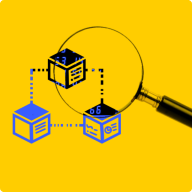Even though the Ethereum merge, the long-awaited transition of the blockchain to a proof-of-stake consensus mechanism, has been completed, issues remain with high transaction fees and congestion. One protocol that aims to help with these problems is the blockchain-based project Loopring (LRC).
What is the Loopring protocol?
Loopring is a program designed to work on top of Ethereum’s blockchain (a layer 1, or base, blockchain). This means that Loopring seeks to make the experience of using Ethereum faster by processing elements of Ethereum transactions on its own network. You can think of it as creating a side road off the main highway to help ease congestion.
Loopring’s developers claim this helps the protocol reach throughput approximately 1,000 times greater than Ethereum, with peaks of 2,025 transactions a second. Unlike Ethereum’s sky-high fees, transactions on Loopring cost less than a cent.
You may have heard of other blockchains, such as Avalanche and Solana, that also claim to be faster and cheaper than Ethereum. However, unlike Loopring, these are known as layer 1 blockchains. This simply means they are independent blockchains with their own validators, just like Ethereum.
Loopring’s token powers an eponymous decentralized exchange that lets you trade Ethereum tokens, like USDC, AAVE and ETH, at a fraction of the cost of decentralized applications native to the Ethereum blockchain, such as Uniswap.
Key features of Loopring
Loopring accomplishes its high throughput and low cost through something called zkRollups. Let’s break that down.
Zk stands for “zero-knowledge,” which itself is short for “zero-knowledge proofs.” This is a method of processing transactions privately. It allows one party to prove to another party that something is true without providing any extraneous information about the transaction itself.
A zero-knowledge proof could let you know that it is raining today without having to look out the window, or prove to a border control agent that you are eligible to enter the country without telling your name and address. Zero-knowledge proofs are important for cryptocurrency protocols that don’t want to leak excess information to third parties or trust a central organization in case something goes wrong.
Rollups are a type of scaling system that collects batches of transactions, then “rolls” them up into a single transaction and processes it on a base layer blockchain like Ethereum. Rollups are a way of cutting costs and increasing speeds because multiple transactions can be processed at once and split the cost of a single transaction.
ZkRollups combine both of these technologies. Looping describes it as “the most secure scaling mechanism the industry knows of, whereby users can access their assets in all circumstances.” It’s suitable for applications that require trustlessness, like decentralized exchanges or lenders.
Loopring’s token
The Loopring network is powered by its native utility token called loopring (also known by its ticker, LRC).
LRC launched in 2017 and primarily powers Loopring’s decentralized exchange , which launched in February 2020. When using the DEX, you have to pay in LRC each time you process a trade. Precisely 80% of the money goes to liquidity providers, and the remainder is split between insurers and Loopring’s decentralized autonomous organization (DAO).
What makes LRC price go up and down?
Like any cryptocurrency, LRC is highly volatile. LRC boomed at the end of October 2021, rising from $0.38 to all-time highs of $3.70 within a fortnight. Analysts linked the rising price to rumors that GameStop, the video game retailer that was central to a social media-fueled surge at the beginning of 2021, would use Loopring to create a marketplace for trading non-fungible tokens (NFT) – blockchain-based art. This rumor did prove to be true, as GameStop did launch its NFT marketplace using Loopring. This however has not driven the price to rebound to earlier highs. The price of LRC in 2022 has fallen steeply with the majority of tokens during the crypto bull market and has fallen to as low as 30 cents as of Sept. 2022.
More broadly, some analysts think LRC’s price is pegged to the success of Ethereum and rival scaling systems and layer 1 blockchains. Some people think the need for scaling will dissipate if Ethereum scales itself, while Ethereum’s co-founder, Vitalik Buterin, thinks the two advancements will complement each other.
DISCLOSURE
Please note that our privacy policy, terms of use, cookies, and do not sell my personal information has been updated.
The leader in news and information on cryptocurrency, digital assets and the future of money, CoinDesk is a media outlet that strives for the highest journalistic standards and abides by a strict set of editorial policies. CoinDesk is an independent operating subsidiary of Digital Currency Group, which invests in cryptocurrencies and blockchain startups. As part of their compensation, certain CoinDesk employees, including editorial employees, may receive exposure to DCG equity in the form of stock appreciation rights, which vest over a multi-year period. CoinDesk journalists are not allowed to purchase stock outright in DCG.
:format(jpg)/cloudfront-us-east-1.images.arcpublishing.com/coindesk/PKNDY5IZQVG7BLWQ7UCPLLFWAQ.jpg)

:format(jpg)/cloudfront-us-east-1.images.arcpublishing.com/coindesk/DMG6DBTBSNHYRJNLOYIOQDROGI.jpg)
:format(jpg)/cloudfront-us-east-1.images.arcpublishing.com/coindesk/PFTJB3CBBZCGPEUSNCEZ7F3Z7U.jpg)
:format(jpg)/cloudfront-us-east-1.images.arcpublishing.com/coindesk/PJTR3KRDWJCRVE3QREM6KUOK7A.png)
:format(jpg)/cloudfront-us-east-1.images.arcpublishing.com/coindesk/FBKUMHO4CJFYPNW2J7ZSXYCBU4.png)


